Virtual Reality games offer immersive gaming experiences by transporting players into digital worlds. These games utilize advanced technology to create environments that players can interact with and explore. Through VR headsets and motion-tracking devices, players can experience a heightened sense of presence and engagement within the game.
VR games encompass various genres, from action and adventure to simulation and puzzle-solving. The technology allows players to physically move within the virtual environment, making gameplay more intuitive and realistic. This level of immersion provides a unique and captivating gaming experience, allowing players to feel as if they are truly inside the game world.
Virtual Reality Games: Where Imagination Comes to Life
VR games have revolutionized the gaming industry by providing a platform where imagination truly comes to life. Unlike traditional gaming experiences, VR games offer players unparalleled immersion and engagement.
By wearing a VR headset, players are transported into intricately crafted digital environments that surround them in 360 degrees. This immersive nature of VR games allows players to feel as if they are physically present within the game’s world, enabling them to explore, interact, and experience the virtual setting firsthand.
Nowadays, there is also a certificate program in VR that helps in learning the technology behind VR games, as it involves sophisticated head tracking, motion sensors, and realistic 3D graphics. These elements combine to create a seamless and convincing virtual experience where players can look around, move their bodies, and even use specialized controllers to interact with objects and characters in the game world.


POSTGRADUATE PROGRAM IN
Multi Cloud Architecture & DevOps
Master cloud architecture, DevOps practices, and automation to build scalable, resilient systems.
VR Games: Explore the Thrills of Virtual Reality Gaming
Immersive Environments: VR games transport players into fully immersive 3D environments. This heightened sense of presence makes players feel inside the game world, leading to a more intense emotional connection with the game’s setting, characters, and events.
Sensory Engagement: VR games engage multiple senses, including vision and hearing. This sensory immersion amplifies the overall experience, making actions and events within the game world feel more real. The ability to look around and hear sounds coming from different directions adds depth that traditional games can’t replicate.
Physical Interaction: VR games often require players to use motion controllers or other input devices to interact with the virtual world. This physical engagement translates players’ real-world movements into the game, creating a sense of agency and control. Whether swinging a sword, aiming a gun or solving puzzles through tactile manipulation, the direct interaction intensifies the sense of thrill.
Adrenaline-Pumping Gameplay: Many VR games are designed to be physically engaging. Whether dodging bullets, running from enemies, or engaging in intense combat, the physicality of VR games and gameplay can trigger an adrenaline rush that traditional games might not achieve to the same extent.
Heightened Realism: VR games and their graphics, and physics simulation enhance the thrill. The sensation of depth and scale adds to the excitement of being in the game world. Realistic physics and object interactions also contribute to a more authentic and immersive experience.
Virtual Reality Headset: Your Gateway to a Virtual World
A Virtual Reality headset is a device that immerses users in a computer-generated virtual environment, allowing them to interact with and experience a digital world as if they were physically present within it. VR headsets typically have a wearable display unit, audio components, and motion-tracking sensors. The primary goal of a VR headset is to create a sense of presence, where the user feels as though they’ve been transported to an entirely different reality.
Here’s how a VR headset generally works:
Display: The headset contains one or two high-resolution displays—one for each eye—to create a 3D effect. These displays are positioned close to the user’s eyes to cover their field of view and provide a stereoscopic view, adding depth to the virtual environment.
Motion Tracking: To make the experience immersive, the headset uses sensors to track the user’s head movements and adjusts the virtual perspective accordingly. This is essential for providing a natural and responsive view of the virtual world as the user looks around.
Audio: Many VR headsets have built-in headphones or earbuds that provide spatial audio. This means sounds are heard from different directions, enhancing the feeling of being present in the virtual environment.
Input Devices: VR systems often include handheld controllers or even gloves equipped with sensors. These allow users to interact with objects and navigate within the virtual world.
Computer or Console Connection: VR headsets must be connected to a powerful computer or a gaming console that can render the complex graphics required for a convincing VR games experience. Some standalone VR headsets have computing power built into the device itself.
Content: Various applications and games have been developed specifically for VR, offering experiences ranging from gaming and entertainment to educational and professional training scenarios.
Google Cardboard: Affordable Virtual Reality Experience
Google Cardboard was a virtual reality (VR) platform developed by Google to provide an affordable and accessible VR experience. It was introduced in 2014 and aimed to bring VR technology to a wider audience by using simple materials and leveraging the ubiquity of smartphones.
The concept behind Google Cardboard was quite straightforward: users could assemble a makeshift VR headset using a simple cardboard viewer, lenses, and a smartphone. The smartphone would act as the display and computing unit, and the lenses would help create a 3D effect by dividing the screen into two slightly offset images, one for each eye.
To use Google Cardboard, users need to download compatible VR apps from the Google Play Store (for Android devices) or the App Store (for iOS devices). These apps would provide various VR experiences, such as 360-degree videos, virtual tours, and simple games, that users could enjoy by placing their smartphone into the Cardboard viewer and wearing like a headset.

PlayStation VR 2: Next-Level Gaming with Virtual Reality
Some features and improvements include:
Higher Resolution: The PlayStation VR 2 could display a higher resolution than the original, resulting in sharper and more detailed visuals.
Improved Tracking: Enhanced tracking technology could provide more accurate and responsive tracking of the player’s movements, reducing motion sickness and improving overall gameplay.
Better Controllers: New and improved controllers with advanced haptic feedback and improved motion tracking offer more realistic interactions within virtual environments.
Wireless Connectivity: The new headset features wireless connectivity, reducing the reliance on cables and making the setup and gameplay experience more convenient.
More Comfortable Design: This creates a more comfortable and ergonomic design for extended gaming sessions.
Upgraded Audio: The audio experience is enhanced with more advanced 3D audio technology, further immersing players in virtual worlds.
Enhanced Processing Power: The PlayStation VR 2 has access to more powerful hardware, allowing for more visually impressive and complex VR experiences.
Backward Compatibility: This ensures that the new headset is compatible with some or all of the existing PlayStation VR titles, allowing players to continue enjoying their favorite VR games.
Conclusion
Virtual reality games have ushered in a new era of immersive and captivating gaming experiences. One can Create the Virtual Worlds of Tomorrow With a Game Design Program to watch the fusion of advanced technology with gaming has allowed players to transcend traditional boundaries and delve into virtual and augmented worlds that engage their senses and emotions like never before. Through virtual reality and Extended Reality games, players can explore fantastical realms, conquer their fears, and develop valuable skills in once unimaginable ways.
What is the best VR game?
Which VR games are right for you?
How do I access and play Virtual Reality games?
Are Virtual Reality games suitable for everyone, including beginners?
Are Virtual Reality games only limited to gaming PCs and consoles?
Updated on July 4, 2024
